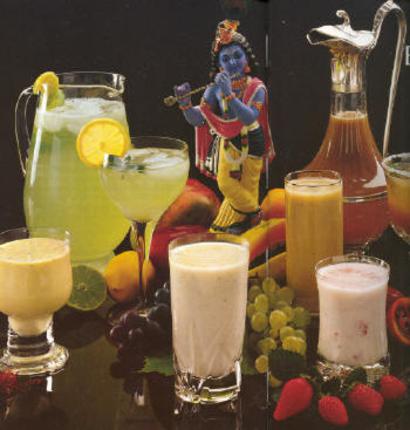What is Taste?
By Kurma Dasa
For many years I have been intimately connected with all stages of the food experience: Study of food history and geography, recipe research and development, writing and testing recipes, growing plants and herbs, shopping and selecting ingredients, menu planning, teaching, and the penultimate, cooking.
However, the climax of all these is, and will always be, the final enjoying experience.This is further facilitated by the sense of taste.
All the above facets would have been a dry experience – akin to licking the outside of a jar of honey – and would have held little significance or attraction were it not for the sense of taste. Yet there is more:the sense of taste holds no meaning without it’s object – flavour.
The human craving for flavour has been a driving force in history. Royal empires have been built, unexplored lands have been traversed, great religions and philosophies have been forever changed by the spice trade. In 1492 Christopher Columbus set sail to find seasoning. Today the influence of flavour is no less decisive. The rise and fall of corporate empires – of soft drink companies, snack food companies, and fast food chains – is frequently determined by how their products taste.
When we strip away the psychology of the eating experience, beyond the culture, the aesthetics, the social aspects, and nutritional needs, we are left with flavour. It is the quality of flavour that people seek most of all in food. Yet this flavour is present in a quantity too infinitesimal to be measured by any traditional culinary terms such as grams, ounces or teaspoons.
Our modern food industry uses sophisticated spectrometers, gas chromographs, and headspace vapour analysers to provide a detailed map of a food’s flavour components, detecting chemical aromas in amounts as low as one part per billion.
But the human nose is still more sensitive than any machine yet invented. A nose can detect aromas present in quantities of a few parts per trillion – an amount equivalent to 0.000000000003 percent. The smell of a strawberry, for instance, arises from the interaction of at least 350 different chemicals that are present in minute amounts.
You might be wondering here how we got on to talking about the nose. Weren’t we discussing taste? The answer is that you can’t have one without the other. The aroma of food is responsible for up to 90 percent of its flavour.
We know that the taste buds on our tongues can detect the presence of a half dozen or so tastes, including sweet, sour, bitter, salty, astringent and hot. The taste buds however offer only a relatively limited means of detection compared to the human olfactory system that can perceive thousands of different aromas comprising myriad chemical constituents. What we call flavour is, in fact, primarily the smell of gases being released by the chemicals you’ve just put in your mouth.
The act of chewing, sucking or drinking a substance releases its volatile gases. They flow out the back of the mouth and up the nostrils, or up the passageway in the back of the mouth, to a thin layer of nerve cells called the olfactory epithelium, located at the base of the nose, right between the eyes. The brain combines the complex smell signals from the epithelium with the simple taste signals from the tongue, assigns a flavour to what’s in your mouth, and decides if it’s something you want to eat.
A person’s food preferences, like his or her personality, are formed during the first few years of life, through a process of intense conditioning by parents, peers and society. Toddlers can learn to enjoy hot and spicy foods, bland food, or fast food, depending on what people eat around them. This explains why many of us have a favourite food which was originally prepared by our mother, and how it is that no other cook can seem to provide that same taste sensation.
Aroma and memory are also somehow inextricably linked. I am sure we all have experienced a smell that brought us back 20, 30 or even 50 years to evoke a powerful, long forgotten memory.
The human sense of smell and taste goes further and can be greatly affected by psychological factors and expectations, and is certainly still not fully understood .
Yet above this there are higher, transcendent aspects of smell and taste. Perhaps these subjects are beyond the scope of modern science, yet to me they seem tangible and real. My years in the kitchen have always been underscored by my spiritual perspectives. It wouldn’t be fair to conclude this essay without sharing some of those perspectives of smell and taste with you.
In India’s spiritual language Sanskrit, we find the word punya. Punya means ‘that which is not decomposed’, or ‘the original’. My first encounter with this word was in the classic Bhagavad-gita. I bought a copy in Sydney back in 1970 when I used to visit the old shop-front Hare Krishna temple after school. A fragment of one of the Gita’s 700 verses has always stayed with me:
‘punyo gandhah prithivyam ca’
The meaning of this phrase is “I am the original fragrance of the earth”. Krishna, the Supreme Personality of Godhead, is telling his friend and disciple Arjuna of some of his divine qualities. Everything in this world, he says, has a certain flavour or fragrance, like the flavour and fragrance of a flower, or in the earth, in water, in fire, or in air. The uncontaminated original flavour, which permeates everything, is in fact God.
This initial introduction to transcendence stimulated something very deep inside me, and gave me inspiration to delve further. I read of how scholars of India’s classic spiritual literature have compared the Vedas to what is known as a “desire tree” because they contain all things knowable. They deal with mundane necessities as well as spiritual realization. The Vedas contain regulated principles of knowledge covering social, political, religious, economic, military, medicinal, chemical, physical and metaphysical subject matter and all that may be necessary to keep the body and soul together.
Above and beyond all this are specific directions for spiritual realization. Regulated knowledge involves a gradual raising of the living entity to the spiritual platform, and the highest spiritual realization is knowledge that the Personality of Godhead is the reservoir of all spiritual tastes, or rasas.
Every living entity, whether human, bird, beast or insect, desires to relish some sort of taste derived from sense perceptions. These sensual pleasures are technically called rasas. Such rasas are of different varieties.
The sum total of all these rasas is called affection or love. Spiritual exchange or rasa is fully exhibited in spiritual existence between living beings and the Supreme Lord. The Supreme Personality of Godhead is therefore described in the shruti-mantras, Vedic hymns, as “the fountainhead of all tastes.”
Seeing taste, flavour, and indeed the world from this fascinating and unique perspective has enabled me to gain access to what must surely be a complete picture of reality.
Source: www.kurma.net

